No Four in a Row is played on a square grid, which can vary in size according to the level of difficulty.
In a hurry? Jump to: Rules / Tips / Worked Example / Video Tutorial / Download Puzzles / Books
Some of the cells in the grid are pre-filled with either Xs or Os. The objective of the puzzle is to fill in the rest of the grid. Here’s an example of a small No Four in a Row puzzle:
There’s only one rule for this puzzle, and the clue is in the name! The grid must be filled such that there are never four (or more) of the same symbol (X or O) appearing consecutively either horizontally, vertically, or diagonally.
Here’s the example puzzle from above, once it’s been solved:
Solving these puzzles is about eliminating and forced placement. It shares some similarities with Binairo, so some of the same techniques can be used. Here are some tips to help you get started, and then we’ll work through a puzzle to put them into practice.
Now we’ll work through a puzzle from start to finish, to put some of those tips into practice. There’s a single valid solution to any given puzzle, but many of ways of reaching it. This example is not meant to show the best way, or fastest way, of solving the puzzle. It’s one possible path that could be taken, and demonstrates some solving techniques at work.
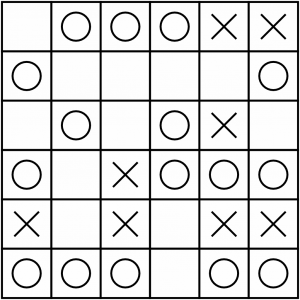
This is the puzzle we are going to solve. It’s a bit smaller than a regular level 1 puzzle, but about the same level of difficulty. We’ve kept it smaller so this example doesn't get unnecessarily long.
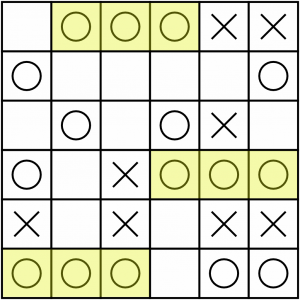
We can begin by looking for “triples” – three of the same symbol in a row. There are three on this puzzle, though the middle one doesn’t have any empty squares next to it so doesn’t do anything for us. We can go ahead and put Xs to the empty squares immediately adjacent to the other two triples though.
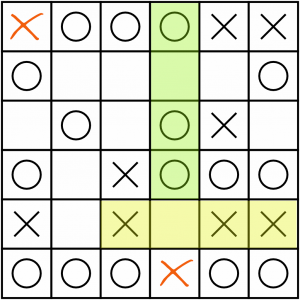
The other kind of quick win we can look for is the 2+1 formation. There are two of those on here. We can put the opposite symbols in the gaps, to prevent getting four symbols the same in a row.
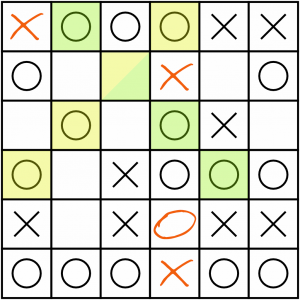
We mustn’t forget to check the diagonals as well. Here we’ve got two 2+1s in the diagonal orientation. Either one would be enough to tell us how to fill the empty cell.
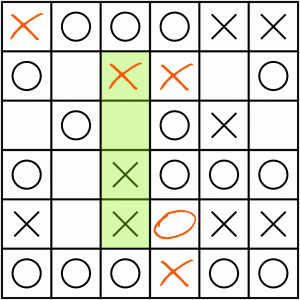
The knock on effect of placing that last X is that we’ve got a new 2+1 here…
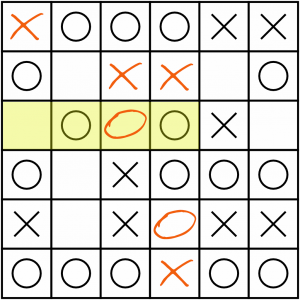
…and filling that in gives us a triple here…
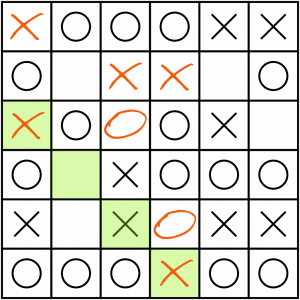
…the completion of which gives us a 2+1 on the diagonal here…
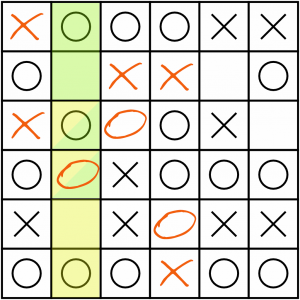
…and that gives us two 2+1s here!
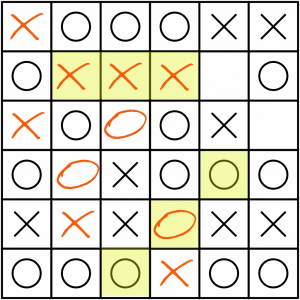
Now we’ve got a couple more triples which will let us complete the last two squares.
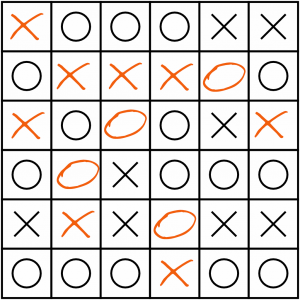
And that’s it, all done! As I say, this was an easy puzzle, and smaller than a real Level 1 puzzle, but the logic and technique is the same. Harder puzzles require some more thinking to reach the solution. Ready to try something a bit tougher? Read on…
We’ve put together a taster of four puzzles for you, including the example above, and a couple of bigger Level 1 puzzles too. You can download and print the PDF below. Solutions are included, just in case you get stuck.
Download Our No Four in a Row Taster
We include seven levels of No Four in a Row puzzles in Puzzle Weekly from time to time. Puzzle Weekly is our free weekly magazine – find out more, and get your copy, here.
You can also find four levels of these puzzles in our Jumbo Adult Puzzle Book, which includes more than 500 puzzles of twenty different varieties – amazing value!